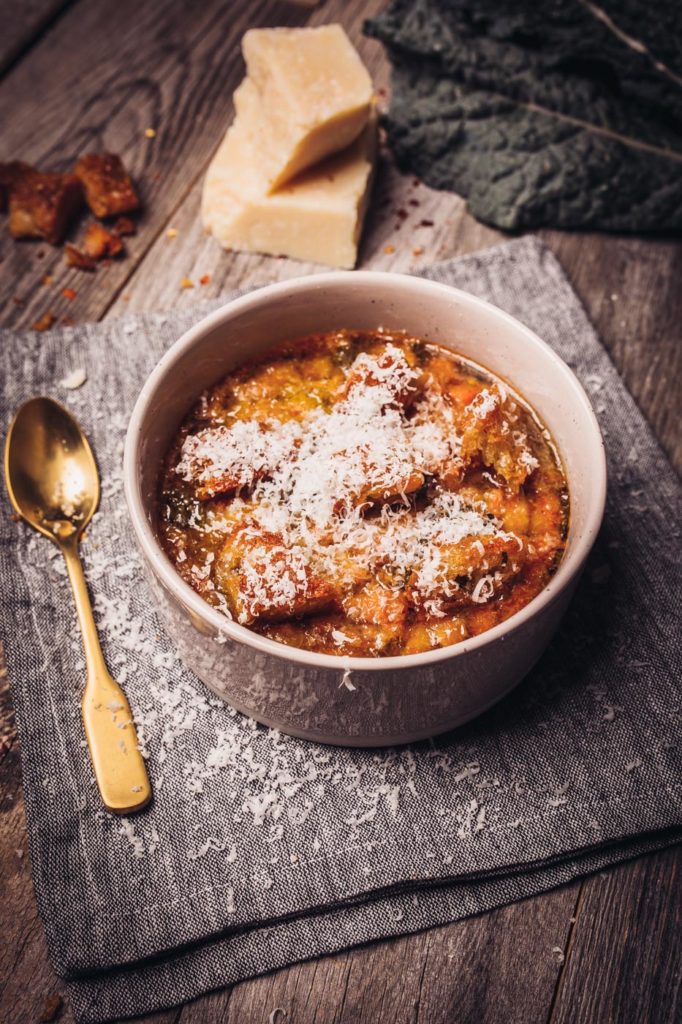
Tuscan Ribollita Soup
Yield: 10 servings
Time: 4 hours, 30 minutes
Ribollita is a traditional Tuscan soup, which, like so many dishes created for la cucina povera, is loaded with vegetables and often fortified with bread, making for a hearty, sustaining meal. The word literally translates to “reboiled” and is traditionally adaptable to seasonal produce. When adding the beans, be very gentle when you are stirring so you don’t break the skins of the beans. It’s also very important to reduce the heat once the beans are added and the stock comes up to boil. It’ll all become mush soup if handled aggressively.
Around the world and throughout history, soup has been a humble way for cultures to survive. Even a quick look at cuisines globally reveal soup’s ubiquity; and although they’ve often been functional, failsafe form of sustenance, that hardly means they’re boring. In a simple bowl of soup, we see culture come alive, brimming with local ingredients. It’s a full creative expression of the people who invented each and every one.
Ingredients
For the sofrito:
- 2 carrots, finely diced
- 1 sweet onion, finely diced
- 3 celery stalks, finely diced
For the soup:
- 2 carrots, medium diced
- 1 sweet onions, medium diced
- 3 celery stalks, medium diced
- 1 bunch kale, stems removed and medium diced, leaves rough chopped
- 15 garlic cloves, minced
- 2 tsp. red chili flakes
- 2 cup dry white wine
- 1 28 oz. can crushed san marzano tomatoes
- 6 oz. parmesan rind
- 3 quarts chicken stock
- 4 slices rustic bread, crust removed and cubed
- 1 lb. dry white beans, soaked overnight or using the quick-soak method below
- 2 tbsp. neutral oil (grapeseed or peanut)
- Kosher salt
- Black pepper
For the garnish:
- Extra virgin olive oil
- Croutons
- Grated parmesan
Method
For the beans:
- Soak white beans overnight in water, or use the quick-soak method here:
- In a large pot, cover beans with cold water. Make sure the pot has enough room for the beans to rehydrate.
- Bring water just to boil and turn off the heat.
- Cover the pot and steep for 1 hour.
For the sofrito:
- Bring large Dutch oven to medium low heat.
- Add oil to Dutch oven and add the finely diced vegetables to the pot.
- Stir to coat with oil, then season to taste with salt.
- Slowly caramelize vegetables about 30 minutes to an hour, stirring often, until vegetables are a dark amber color.
For the soup:
- Add minced garlic and red chili flakes to the sofrito. Stir and sweat for 1 minute.
- Add the medium diced carrots, sweet onion, celery stalks and kale stems to the pot. Salt and pepper to taste and sweat for 1 minute.
- Add the white wine and deglaze while scraping the brown bits from the bottom of the pot.
- Reduce white wine until alcohol has burned off, for about 2 minutes.
- Add crushed tomatoes, and cook down to jam consistency, stirring frequently for about 5 minutes.
- Salt tomato jam to taste.
- Add white beans, parmesan rind, bread cubes and chicken stock. Stir very gently and bring to boil.
- As soon as it starts to boil, reduce to a very low simmer and cook for 1 ½ hours, or until beans have softened and broth has thickened. Stir occasionally and gently to make sure parmesan rinds don’t burn at the bottom of the pot.
- Once the beans are tender and broth has thickened, add the kale leaves and season with salt and pepper to taste. If more acid is needed, add lemon juice to taste.
- Remove parmesan rinds before serving.
- Ladle into individual bowls and garnish with a drizzle of olive oil, croutons and grated parmesan.


Our comments section is for members only.
Join today to gain exclusive access.